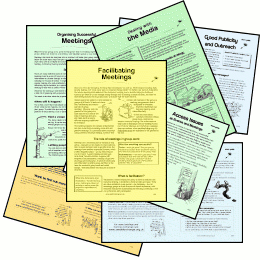Some resources on Change
John Courtneidge
12 September 2013
Contents:
1) From Google search: How change happens
2) Movement Action Plan (MAP) - Bill Moyer:
3) International Centre of Nonviolence , (Sydney
Australia)
5) Seeds for Change
6) Energy profiles from chemistry:
------------------------------------------------------------------------------------
1) From Google search: How change happens
a) Renato Cardoso:
How Change Happens:
Two step process: dissatisfaction/anger emotions
followed by whole-hearted commitment (mind, body, spirit, wholeness,
resources - tools people, money, expertise - and, finally, speech -
speak out!) to surpass Resistance:
https://www.youtube.com/watch?v=hikH21emAiY
Renato Cardoso blog:
http://www.renatocardoso.com/en/
b) Ian MacKenzie:
How Change Happens
15 views! Uploaded three months' ago (ie about June
2013):
https://www.youtube.com/watch?v=6gQarnbBh50
My comment, there, to it:
Very fine video! - if you're interested in a discussion
on effecting beneficial change, please be in touch
john@courtneidgeassociates.com or via a blog
sustainabilitynotcapitalism.blogspot.com a web-site
interestfreemoney.org or my facebook page thx!
c) Marianne Williamson on Occupy: Keep it smart, keep
it nonviolent, keep it growing
https://www.youtube.com/watch?v=EZPna2RfXzE
ps My original hope was to find a ?two-minute seminar
from her that suggests something like 'when 11% of a population 'get
it' every-one follows' - but I've not refound that yet . . .
--------------------------------------------------------------------------------------------------
2) Movement Action Plan (MAP) - Bill Moyer:
https://en.wikipedia.org/wiki/William_Moyer
The second external link gives:
http://historyisaweapon.com/defcon1/moyermap.html
Movement Action Plan
From Wikipedia, the free encyclopedia
The Movement Action
Plan is a strategic model
for waging nonviolent social
movements developed by Bill
Moyer, a US social
change activist.
The MAP, initially developed by Moyer in the late 1970s, uses case
studies of successful social movements to illustrate eight
distinct stages through social movements' progress, and is designed
to help movement activists choose the most effective tactics
and strategies
to match their movements' current stage.
The eight stages
Moyer describes the eight stages as:
- Critical social problem exists
- Prove failure of official institutions
- Ripening conditions
- Take off
- Perception of failure
- Majority public opinion
- Success
- Continuation
External links
-------------------------------------------------------------------------------
3) International Centre of Nonviolence , (Sydney Australia)
Video of founding event February 2013:
http://www.nonviolence.org.au/video-gallery/
Launched on 2
October 2012 when celebrating UN International Day of Nonviolence and
commemorating the anniversary of Mahatma Gandhi’s birth:
Our vision is of a nonviolent society based on the celebration of our common humanity and of the natural environment that sustains us. We will work to make strategic interventions in education – development of educators and curricula, teaching and writing – that challenge structural violence, enable learning untainted by violence and advance a culture of nonviolence. It works through reflective practice and focused research to develop and disseminate its understanding, and to build networks of educators with a similar vision and commitment
From there:

---------------------------------------------------------------------------
4) Brian Martin
Web-site: http://www.bmartin.cc/
Book: 'Nonviolence versus
capitalism' War Resisters International, London 2001
– on line at:
Summary
Nonviolent action is the most promising method of moving beyond capitalism to a more humane social and economic system. How can this be achieved? Nonviolence versus Capitalism offers a systematic approach, starting with an analysis of capitalism from the viewpoint of nonviolence, outlining nonviolent economic alternatives and describing what is involved in a nonviolence strategy. A check list for activists is proposed and used to assess diverse campaigns, including workers' struggles, sabotage, environmental campaigns, social defence, global campaigns and economic alternatives.---------------------------------------------------------------------------------------------------
5) Seeds for Change:
Workshops
and Resources
for grassroots activists
Seeds for Change - activists providing support and training to activists, campaigners, community groups and co-operatives.
We're a network of activist training co-ops providing training and workshops on group and campaign skills. We support people who want to make our world a better and more sustainable place.Have a look at our guides and briefings which have lots of practical skills and ideas to make your meetings run smoothly and painlessly, not to mention making your campaign or project a success! We cover topics like consensus decision making, facilitating meetings, how to win your campaign, publicity, and taking action. All our materials are free.
 Here's
just some of the workshops we can offer - if you want something
that's not on this list then ask us - we may be able to help, or know
someone who can.
Here's
just some of the workshops we can offer - if you want something
that's not on this list then ask us - we may be able to help, or know
someone who can.- Consensus Decision Making and Facilitation - make your meetings inclusive, creative and effective.
- Campaign and action skills, work out a strategy for your campaign.
- Co-ops - help in setting up your co-op, work out how to work together, choose a structure, work out your business idea.
- Training for trainers - how to plan and run
your own great workshops.
----------------------------------------------------------------------------------------------
6) Energy profiles from chemistry:
Please see attached diagrams for exothermic and
endothermic changes.


No comments:
Post a Comment